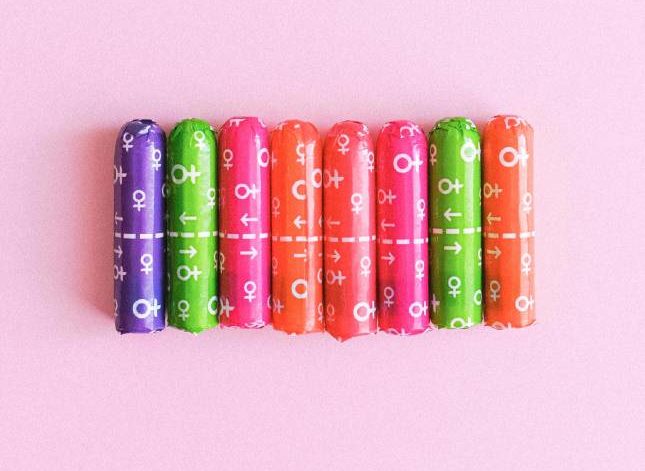Ever wondered just what you’re putting into your body when you insert a tampon? According to a recent study by researchers at the University of California, Berkeley there’s a lot more to your average tampon than cotton and rayon. It seems that tampons have become a bit of a health hazard because of their chemical contents. Think heavy metals like lead, hormone disrupting chemicals like phthalates and a host of chemicals used in manufacture like whitening agents, antimicrobials and lubricators. Dealing with the monthly bleed just got a whole lot messier. In this article you’ll learn which toxic chemicals have been found in tampons and how to better navigate the world of feminine hygiene products.
Study finds heavy metals in tampons…
This study is touted as the first of its kind to measure the presence of toxic metals in tampons. In 2024….. Took us long enough! Half the world has periods you know! This is information every woman needs to know because once menarche occurs (often around the age of twelve for most women), we find ourselves truly in the experience of menstruation and womanhood. And many of us are trying to contend with irregular bleeds, heavy bleeds, bloating, pain, bloating, acne, premenstrual syndrome, food cravings, headaches…. We want to know that the sanitary products we’re being offered are safe as a minimum.
Sixty years ago reports of adverse effects with tampons, like tampon-related toxic shock syndrome (TSS), started building. TSS occurs mainly in menstruating women and is a rare but serious illness that causes symptoms like sudden fever, vomiting, diarrhoea, low blood pressure and muscle aches. Between 1970 and 1980 over 900 cases were reported. 73 of these women died. This led to the development of the Tampon Task Force in 1982 in the USA who looked at manufacture and safety of tampons. It’s not as simple as the structure or design of a tampon though, or it’s effect on flow or it’s absorbency. There are actually a few co-existing elements that lead to tampon-related toxic shock syndrome and they are:
- The presence of Staphylococcus aureus in the vaginal flora
- Not having enough antibodies to effectively neutralize toxic shock syndrome toxin-1 (TSST-1) in the vagina
So TSS can occur in men and children as well, in these cases it’s just not tampon related. But it’s still toxic shock syndrome.

Photo Viktoria Slowikowska
If you’re interested in learning more about this you could listen to Sharra Vostral’s podcast episode ‘Under wraps: A History of Menstrual Hygiene Technology and TSS.
So the vaginal microbiome and it’s health status plays a role in the development of toxic shock syndrome. Want to work on your vaginal microbiome? I have a vaginal health protocol, get in touch and we can talk about whether it would be suitable for you. I have products specifically designed to improve vaginal microbial balance.
A Summary of findings from the study on toxins in tampons
So what did they find in this 2024 published study? Here are the main chemicals found in tampons that pose a health risk to women worldwide….
16 metaloids were identified in several kinds of tampons: arsenic, barium, calcium, cadmium, cobalt, chromium, copper, iron, manganese, mercury, nickel, lead, selenium, strontium, vanadium, and zinc.
You may already be familiar with iron, zinc, calcium, chromium selenium and manganese. You might even have taken a supplement containing them in the past, or perhaps you took one today. I prescribe iron frequently in clinic because around a third of the global population is iron deficient, it’s really common these days. Chromium is another one I regularly use for polycystic ovarian syndrome, prediabetes, insulin resistance and fatigue. It’s wonderful for helping us build our energy levels by converting the food we eat into usable energy more effectively.
I use zinc for hormone regulation because often it’s deficient in hormonal conditions and it’s essential for hormone balance. And calcium is great for bones and heart health, manganese plays a role in stubborn food sensitivities….but the thing about metals is, well, exactly that. They’re metals. They’re heavy, mineral, and they can build up internally. They’re also not always easy for our bodies to breakdown and dispose of if they become excessive.
And as the alchemist Paracelsus said, ‘the dosage is the poison’. It’s true. Anything can be good in smaller doses, and anything can be harmful in persisting and high doses. Except for smiles and kindly hugs 
Other key findings from the study were:
- Levels of metalloids varied between products but each tampon product contained five or more metals.
- Tampons are a ‘potential source of exposure to metals in menstruating people’.
- Non-organic tampons tended to have higher concentrations of lead. Were organic tampons any better? Get ready for this one… organic tampons were comparatively higher in arsenic. Yikes!

From the study by Shearston et al (2024)
Are tampons safe?
So you’re probably wondering, ‘are tampons safe?’ ‘Which brands have heavy metals?’ ‘are organic tampons safer?’
One problem with interpreting the study results is that we don’t actually know which brands were tested. We know how many brands were used, and how many product lines, and we also know a mix of non organic and organic were tested. But we can’t definitively say which brands to avoid or support.
I thought it might be useful to give you an idea of some of the common symptoms of heavy metal excess so that you can determine yourself, how much of a concern these findings might be. You might not have any symptoms and feel fairly comfortable with going organic and minimising your exposure to certain chemicals that way, although it’s still not 100% guaranteed that organic products will be free of all harmful chemicals. Or you might have a host of heavy metal toxicity symptoms and feel like maybe your menstrual hygiene protocols need a makeover. So here are the signs you’d expect to see with excesses of selected heavy metal(loid)s.
Symptoms of toxic lead (Pb) exposure
- Pain in the abdomen
- Nausea, vomiting
- Elevated liver enzymes on a blood test
- Elevated low density lipoproteins on a cholesterol (lipid) blood test
- Burton’s line – a blue-purple streak where the teeth meet the gums
- Delayed growth in children
- Low birth weight
- Miscarriage
- Reduced sperm count
- Reduced libido in men
- Possibly infertility in males
- Altered lung function
On Lead: “The metal has been associated with a range of neurological and cardiovascular conditions, as well as problems with our kidneys, our blood, our immune system and our reproductive health. Of particular note, even low-level exposure to lead can result in neurobehavioral impacts in adults and children, including decreased cognitive function such as impaired attention, memory, and learning ability,” the researchers wrote. Children are particularly vulnerable to lead exposure, as are unborn fetuses, which might be exposed to lead that is rereleased from the mother’s bones into her blood during pregnancy.” – Pandora Dewan ‘Toxic Metal in Tampons Risks Brain’s Cognitive Function, Scientists Warn’, Newsweek (2024)
Symptoms of toxic arsenic (As) exposure
Arsenic is either organic or inorganic, and the inorganic type (does not contain carbon) is more severely harmful to our health however both types are toxic to humans. It affects the cardiovascular system, hormones, immunity, liver, bladder and kidneys, nervous system, prostate glands and respiratory system as well as the skin.
- Gastroenteritis
- Nausea, vomiting
- Diarrhoea
- Abdominal pain
- Peripheral neuropathy
- Hypotension (low blood pressure)
- Cough
- Chest pain
- Protein in the urine
- Blood in the urine
- Headache
Those are mostly soon after exposure. For longer term chronic exposure these are the symptoms seen:
- Skin hyperpigmentation like ‘raindrop appearance’
- White bands/lines across the finger nails, 1-2mm wide known as ‘Mees lines’
- Alopecia
- Skin cancer
- Lung and bladder cancer
Symptoms of toxic Mercury (Hg) exposure
Mercury is a neurotoxin and it can damage nerve tissues. Symptoms of excess mercury exposure include:
- Impaired movement coordination
- Difficulty coordinating movement when writing
- Impaired speech, hearing
- Loss of peripheral vision
- Mood swings
- Memory loss
- Muscle weakness
- Pins and Needles in the hands and feet
- Pins and Needles around the mouth
- Skin rash
If you’re interested in reading further head to the National Institute of Environmental Health Sciences for overviews of several potentially toxic chemicals and other agents.
Detoxing (Chelating) Heavy Metals
If you’re interested in a detoxification protocol for bettering your health, whether you feel you might have built up undesirable levels of heavy metals or not, I use heavy metal chelating supplements to support the gentle removal of these sorts of metalloids and reduce symptoms, particularly gastrointestinal symptoms. Just get in touch if you’re interested in knowing more.
Are organic tampons safer than non-organic tampons? Is period underwear safer than tampons?
Hmmm, we kind of expect the answer to the first question at least to be a resounding ‘YES’ but (and this is testimony to the world we live in these days) organic products had higher levels of arsenic compared to the non organic. That’s not necessarily better.
By the way, if you’re wondering how many tampons were tested for heavy metalloids in this study, it’s 30 tampons from 14 brands including organic and non-organic.
And before you throw your tampons away just note that most sanitary products for women contain chemicals that may be harmful. PFAS (per- and polyfluroaklyl substances that literally live forever) were yes, found in tampons, around 22% of them. But they were found in 65% of period underwear according to a lab study conducted between 2020 and 2022. You find PFAS in grease-proof food packaging, raincoats, stain resistant clothing and fabrics, non-stick pans and now, menstrual products. They have what’s known as a really long ‘half-life’, which is another way of saying they hang around in your body for a long time. Not minutes or hours, but on average nearly 5 years. PFAS have been linked to health concerns like fertility problems, high blood pressure and irregular cycles. Read more about studies on PFAS in feminine products here.
“In a series of lab analyses commissioned between 2020 and 2022 by the consumer watchdog site Mamavation and Environmental Health News, 48% of sanitary pads, incontinence pads, and panty liners tested were found to contain PFAS, as were 22% of tampons and 65% of period underwear. What’s more, says Leah Segedie, founder and editor of Mamavation, in one of the analyses, out of the 22 products that tested positive for PFAS, “13 of them were advertised as ‘organic,’ ‘natural,’ ‘non-toxic,’ ‘sustainable,’ or using ‘no harmful chemicals.’” In another analysis, 13 of 18 products that made similar claims tested positive for PFAS.” – Jeffrey Kluger (2023) PFAS Forever Chemicals are turning up in menstrual products. Here’s what you need to know. TIME Magazine Health & Wellbeing
How exactly do metals get into tampons?
Metal(loid)s might end up in tampons in a variety of ways, they’re not necessarily ‘added in’ during processing.
- If toxic metals are present in the soil at the time the cotton plants are growing, they can end up in the final product, the tampon.
- There could be contaminated areas nearby that lead to chemicals in the water, soil or products used in tampon manufacture
- It’s possible that the metalloids are added intentionally during processing
If you’re looking for PFAS-free period underwear, check out this list here.
How many of us use tampons?
Statista suggest that 34% of Australian women on average, use tampons regularly. The state with the highest level of tampon use is Tasmania at 38%, followed by Western Australia with 35%. South Australia had the lowest number at 30%. But you see the range is somewhere around a third of all menstruating women on average. This is based on figures from 2015, which are possibly going to drop in 2024 😊. Wonder why…
So if you’re getting together with a couple of friends, chances are one of you uses tampons.
Is vaginal tissue more absorptive of chemicals?
This is a great question that’s been doing the rounds. On one hand we’re rightly concerned about having potentially harmful chemicals in any products we wear on our skin, but this one is going inside us. And despite having many many years to familiarise ourselves with vulvo-vaginal tissues, it tends to be a bit of a mystery to many of us! When’s the last time you chatted about the mucosal lining of your vagina and the vulval area in general? Likely not very often.
And science tells us that vaginal tissue is not like our outer skin. keeping our hands clean is a lot easier that protecting internal membranes from toxins in sanitary products. Exposing vaginal tissues to lead, arsenic and nickel can’t be much fun for the vaginal ecosystem and microbiome. I won’t labour on this point, but if you’re interested have a look at this blog article.

Photo: Polina Zimmerman
Summing up
We’re exposed to heavy metals daily in our water, air, food and cosmetics. Tampons can be considered just another way we find ourselves exposed. If you use tampons, you’re exposed to the chemicals they contain for hours at a time. Often in midlife we can get heavier periods, or more frequent periods, which means, more tampon use for some of us. Also, they’re administered directly into the vagina so the issue of absorption here is a unique one, and we need more testing and research to ascertain exactly how our reproductive systems and organs are being affected.
So in summary, heavy metals are part of our world and we’re exposed to them in a number of ways, not just tampon usage. But that doesn’t mean we shouldn’t:
- Determine if we might have been over exposed to them
- Seek alternative, safer, means to manage menstrual hygiene
Information is key and no doubt there will be more studies coming to give us more data on the safety profiles of tampons, period underwear and other sanitary products. For now, you might like to:
- Advocate for the testing of feminine hygiene products by manufacturers
- Encourage and support studies and testing on tampons and their effects on women’s menstrual experiences
- Advocate for more transparency in labelling on tampons and other sanitary products
- Try a different brand of tampons and see if your next bleed is different…perhaps the tampons have something to do with any period symptoms?
- Read the ingredients labels on any products before you buy them and do your own research.
- Avoid long long lists of ingredients as their more likely to have extra chemicals that may be harmful to your health
- Alternate between different types of menstrual hygiene products, pads, tampons, cups and period underwear
- Try not to panic. Being well informed is the first step, and the more we talk about these things, the more likely we are to build better products in the future
Thanks for reading and take care of beautiful you,


Hey there! Welcome to my world of totally natural and powerful healing medicines. Medicines from nature. Medicine from Source. I’m a naturopath and herbalist with extensive clinical experience working with a range of health conditions including hormonal, metabolic, mental health, sleep and more.
I’ve brought together years of clinical and teaching experience, academic skill and curiosity to bring you this blog. I hope you enjoy it! If you do, leave a comment, I’d love to hear from you!

References
- Key study: Shearston, J. A., Upson, K., Gordon, M., Do, V., Balac, O., Nguyen, K., … & Schilling, K. (2024). Tampons as a source of exposure to metal (loid) s. Environment International, 108849.
- Vostral, S. (2017). Toxic shock syndrome, tampons and laboratory standard–setting. CMAJ, 189(20), E726-E728.
- Daley, G. M., Pretorius, C. J., & Ungerer, J. P. (2018). Lead toxicity: an Australian perspective. The Clinical Biochemist Reviews, 39(4), 61.
- Ratnaike, R. N. (2003). Acute and chronic arsenic toxicity. Postgraduate medical journal, 79(933), 391-396.
- (No Author) Mercury. National Institute of Environmental Health Sciences. 2022
- Kluger, J (2023) PFAS ‘Forever Chemicals’ are turning up in menstrual products. Here’s what you need to know. TIME.
- Dewan, P. (2024) Toxic Metal in Tampons Risks Brain’s Cognitive Function, Scientists Warn. Newsweek.




